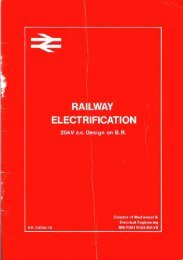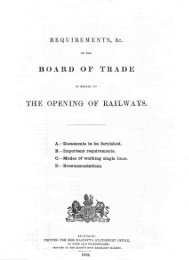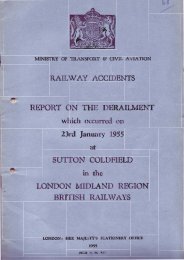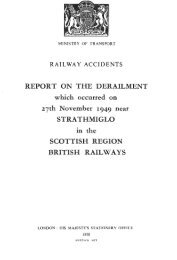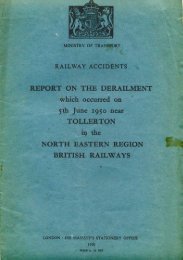R A I LT R AC K - The Railways Archive
R A I LT R AC K - The Railways Archive
R A I LT R AC K - The Railways Archive
Create successful ePaper yourself
Turn your PDF publications into a flip-book with our unique Google optimized e-Paper software.
19 Brighton Main Line and South London network continued<br />
Route characteristics continued<br />
Option D Complete resignalling of the existing three-aspect signalling to four to<br />
i m p r ove headways. It is not considered that resignalling would provide any<br />
s i g n i ficant increase in capacity on the line (no more than one additional path per<br />
hour). Although the ave rage headways on the West London Line are about fo u r<br />
m i nutes, limited benefit could be obtained from resignalling, due to the wide mix<br />
of tra f fic using the line. In addition, reducing signal spacing would only increase the<br />
number of instances when long freight trains bridge two or more signal sections.<br />
Option E Transferring the <strong>AC</strong>/DC electrification interface to a location where a<br />
train is already stationary to release one additional path. Currently, trains have to<br />
stop in both directions to change from one electrification system to the other.<br />
This effectively reduces available capacity by one train path per hour. Transferring<br />
this interface to a location where a train is already stationary, eg at a station,<br />
would increase capacity.<br />
This can be achieved either by extending the overhead line southwards or<br />
the conductor rail northwards. <strong>The</strong> nearest station at present is Kensington<br />
Olympia. However, a new station is proposed at Shepherd’s Bush.<br />
Extension of the OLE would require structure clearance to accommodate<br />
the OLE and immunisation works to ensure compatibility with London<br />
Underground lines. Extension of the conductor rail would require a new<br />
substation at Willesden Junction.<br />
Route vision<br />
Our vision for this route is to increase capacity for south London commuting<br />
services and to enable the interurban commuting and leisure market to grow by<br />
a series of strategic developments.<br />
<strong>The</strong> route must satisfy the still-growing demand for fast, frequent and<br />
reliable services between central London, East Croydon, Gatwick Airport and the<br />
South Coast, while also meeting the developing needs of freight and north of<br />
London services.<br />
Many main line morning peak services into and through London are now<br />
suffering significant overcrowding, and we believe that passenger numbers will<br />
continue to grow. We intend to work with our customers to develop a range of<br />
options, including train lengthening and, in the longer term, major infrastructure<br />
enhancements.<br />
We have already completed an initial study which has two key conclusions.<br />
<strong>The</strong> fi rst is that, in the short term, some improvements can be made at Victori a .<br />
We will begin a £2.6M package of track and signalling enhancements at Victori a<br />
this year as our fi rst phase of the upgrade of the Brighton Main Line. This will ease<br />
congestion at Victoria and is funded entirely by Railtrack. <strong>The</strong> second conclusion is<br />
that an additional four train paths per hour could be created by major<br />
i n f ra s t ructure wo rk at Clapham Junction, East Croydon and Gatwick Airp o rt at a<br />
total cost in excess of £150M. <strong>The</strong> study demonstrated that the additional ticke t<br />
r e ve nue that this would create would not fund the higher operating costs and<br />
interest charges on this investment. We will develop this wo rk further and discuss<br />
our conclusions with the Franchising Director to try and ensure that demand fo r<br />
rail travel is not suppressed in future ye a rs on this key route.<br />
We expect that an upgrade at Gatwick will be the first of these areas to be<br />
Route development and customer requirements<br />
Improving train punctuality when the numbers of trains running on our network<br />
has increased substantially is an enormous task. Working with customers, we will<br />
improve charter punctuality two percentage points over the next two years. This<br />
improvement, which will vary across service groups, will typically result in 16%<br />
fewer trains arriving at their destinations more than five minutes late.<br />
<strong>The</strong> Thameslink 2000 project, by improving track layout in the London<br />
B ridge area, providing a new station at St Pa n c ras and improving facilities at<br />
F a rringdon and Blackfri a rs, will facilitate movements across the capital, provide a<br />
key interface with London Underground and relieve some of the congestion at<br />
V i c t o ria Station. More details of the Thameslink 2000 proposals can be found on<br />
subsequent pages.<br />
<strong>The</strong> WLL will continue to develop as a key artery for local and longdistance<br />
passenger and freight traffic. Potential solutions are described in the<br />
Bottleneck analysis section above.<br />
Discussions are taking place with Borough and County Councils concerning<br />
234<br />
Due to the limited capacity benefit and expected cost, it is not recommended<br />
that this option is pursued in isolation. <strong>The</strong> infrastructure works required would<br />
only be carried out in conjunction with the construction of an additional station<br />
on the line, which would neutralise the effect on overall capacity. <strong>The</strong> full extent<br />
of the works to move the interface has yet to be determined.<br />
Option F Release capacity through flexing, or rerouteing of existing trains. <strong>The</strong><br />
existing traffic mix leads to a very inefficient use of the available capacity, due to<br />
the differing train speeds and stopping patterns. <strong>The</strong> effect of this option would<br />
be to make more efficient use of the available capacity and/or to free up paths<br />
for other operators.<br />
Options for re-routeing freight have been looked at, including the altern a t i ve<br />
routes of Kew Dive rs i o n a ry and North Downs. We have concluded that we<br />
should increase capacity by removal of the linespeed constraint at Chelsea Rive r<br />
B ri d g e, justified by the reve nue from the additional services, together with<br />
assessing the case to move the <strong>AC</strong>/DC interface to a station location.<br />
<strong>The</strong>se are the only available options that will provide any significant<br />
capacity improvement.<br />
addressed. We will seek to create an integrated development plan at Gatwick<br />
Airport to ensure rail can continue to grow its market share. This will put more<br />
pressure on the remaining Clapham Junction and East Croydon bottlenecks for<br />
which we have identified solutions. We wish to proceed with these in<br />
partnership with the Franchising Director and our customers.<br />
We and our customers want to see improved journey times. In the longer<br />
term, these would be built into any major infrastructure enhancements but, in<br />
the short term, opportunities are limited because of the effective capacity of the<br />
route. We will examine economic incremental linespeed improvements during<br />
major maintenance or renewal of the suitable infrastructure.<br />
<strong>The</strong> South London suburban netwo rk is constrained to a maximum of eightvehicle<br />
operation and is now under enormous pressure from increased demand.<br />
While this is good for the ra i lw ay, it has proved ve ry difficult to improve tra i n<br />
punctuality and passenger comfo rt now that all the effe c t i ve capacity in the peak<br />
p e riods is used up. We and our customers are looking at short - t e rm solutions.<br />
Medium- to long-term solutions could be longer trains, together with a platfo rm<br />
lengthening programme to at least ten coaches, more innov a t i ve train solutions<br />
and major infra s t ructure capacity improvements. We will be taking options to<br />
potential funders to agree both the solution and the method of funding.<br />
Capacity improvements on the core central route would, in turn, bring<br />
greater accessibility to the important radial routes to Eastbourne, Newhaven,<br />
East Grinstead and Chichester. It is our determination that the Uckfield Line will<br />
be electrified. <strong>The</strong> timing will be heavily dependent on issues relating to the life of<br />
the current rolling stock.<br />
interchange improvements to be provided in conjunction with a proposed highquality<br />
transport system. This would link residential development areas to<br />
stations, town centres and employment areas at Horley, Gatwick, Three Bridges<br />
and Crawley.<br />
A feasibility study has been undertaken into the development of a<br />
concourse-level airline check-in facility at Victoria, and negotiations are continuing<br />
with various stakeholders to determine commercial arrangements to allow this<br />
project to proceed. We are also developing a programme with Connex to create<br />
key hub-interchanges at East Croydon, Sutton, Three Bridges and Haywards<br />
Heath. A planning application has been submitted for a redevelopment of Epsom<br />
Station, which will enhance the station environment, provide undercover car<br />
parking and improve the customer-information system.<br />
Significant refurbishment of Brighton, Stewarts Lane and Streatham Hill light<br />
maintenance depots currently under way. <strong>The</strong> facilities at Selhurst Depot are<br />
planned to be upgraded, including the provision of a new wheel lathe.



